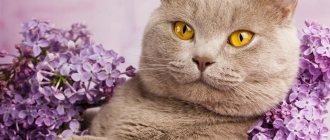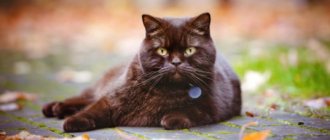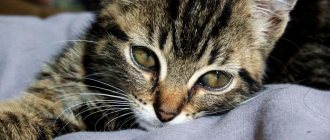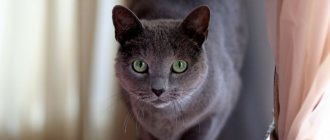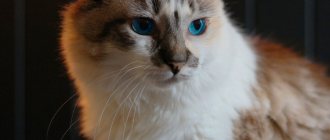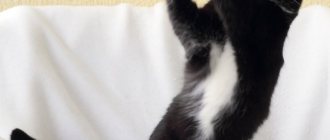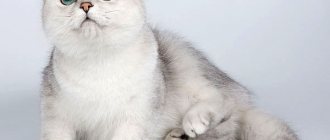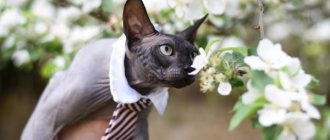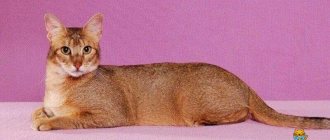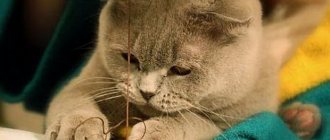The British are real beauties, this breed cannot be confused with any other. The British Shorthair cat is a strong, beautiful and well-proportioned animal with silky fur, regal bearing and expressive eyes. Today, representatives of this breed are the pride of the United Kingdom and are popular all over the world.
History of the origin of the breed
It is believed that the first representatives appeared more than two thousand years ago, but this is not entirely true. Cats came to the island from mainland Europe, according to one version with the Roman conquerors. In the Roman Empire, they, in turn, migrated from Egypt, where, according to some scientists, the domestication of cats began. According to another version, they were brought to Britain by French traders and travelers, and these were representatives of the breed that today is called Chartreuse. This opinion can be confirmed by the striking similarity between the “British” and the “French”.
Once on the territory of modern Britain, cats quickly adapted to the new living conditions and, through natural selection, acquired thick fur and excellent hunting talents. The latter quality was liked by people for whom cats served as assistants in protecting crops from rodents. Therefore, the breed began to be bred at home.
Pictures of cats similar to today's British Shorthairs appear in books and documents dating back to 700-800 years. There is also a stone cross from the 10th century, on which two “Britons” are carved.
In the Middle Ages, persecution of cats began, but it must be said that this happened throughout Europe, and not just in Britain. They were considered accomplices of the evil spirit, they, along with witches, were tortured and killed in various barbaric ways. During the witch hunt as a result of the activities of the Holy Inquisition, the number of British cats was greatly reduced, but they survived.
Already in the 17th century, the famous novelist Daniel Defoe wrote that there were cats in almost every British family. And this is natural: people quickly realized that without tailed helpers they could not cope with rodents destroying supplies.
Real selection, the results of which can be seen today at the most prestigious exhibitions and in television advertising, began only in the 19th century. When describing the breeding of the British, one cannot fail to mention a man named Harrison Weir, an outstanding felinologist who was the first to compile a description of the breed and show its representatives at exhibitions.
At the beginning of the 20th century, standards were already quite defined, cats were divided by color. These were already the same British: with a round head, strong bones, and short thick hair.
In general, the breed was formed by crossing representatives of European and American domestic shorthair breeds, Persian cats and Chartreuse cats.
In the middle of the 20th century, after the devastating World War, there were almost no British left, but enthusiasts managed to defend and preserve the breed. Today, the features of the ancestors of Persian blood and American shorthair cats are clearly visible in it.
Description of the breed
The British are a recognizable breed with a distinctive appearance. Breeders today breed cats of various colors, but the most recognizable is the blue coat color.
Appearance
The head of a British cat is large and round in shape. The muzzle is wide-cheeked, with prominent cheeks. The nose is in a straight vertical line with the chin, in profile it does not protrude much forward, the transition from the forehead to the nose is smooth, but clearly visible.
The ears are located quite low, have a round shape and are small in size.
The eyes are set wide apart, round in shape, large and expressive. The color of the iris is predominantly blue, but some British people may have lavender or emerald eyes.
The body is squat, broad shoulders and a developed chest. The limbs are quite short, but proportional. The paws are short, round in shape, muscular and powerful.
The tail is round, with a rounded tip, uniform along its entire length, somewhat wider at the base. The coat is short, thick, very pleasant to the touch (often these cats are called plush).
British cats are a large breed, the weight of an individual can reach 8-9 kg, on average they weigh 5-7 kg.
Color
British cats can have different colors:
- Solid (coat of one color is uniform, without inclusions of other shades) - the most common is gray-blue, also solid color can be black, chocolate;
- Smoky (pigmentation is observed only at the tips of the hairs, the undercoat is very light, and the tips of the hairs are black, this is a contrasting color, in which the limbs and paws, head and back are dark, and the sides, ears and collar part of the neck are lighter, there are various colors from smoky black to silver);
- Tortoiseshell (represents an even distribution of black and reddish wool or blue and cream fur over the body);
- Tabby (involves the presence of stripes, a marble pattern, various shapes of spots, they must be clearly defined, well separated from the main color);
- Bicolor (bicolor) – the main coat color (tortoiseshell or solid) is combined with white;
- Colored (the whole body is covered with white fur, the tail, paws, ears are pigmented, and the colored areas on the face resemble a mask).
Character
British cats are somewhat similar to the English themselves (in the classical sense): they are very reserved and unobtrusive. These are very independent animals that do not require constant attention. They are great at finding things to do on their own.
Their behavior is filled with a sense of self-worth and importance. They are melancholic, although they watch with interest what is happening in the house. However, they always maintain an independent and slightly detached appearance.
Representatives of this breed do not really like to sit on laps and hands and do not require affection or tactile relationships. This does not mean that they ignore the person or are not attached to him.
When separated from its owner, a Briton can get very bored. However, they do not need manifestations of love in the form of cuddling and kissing.
The British are patient, but do not tolerate change of scenery or large numbers of people and noise around them. They treat children well, but prefer to keep their distance. They will not intentionally harm the child; rather, they will try to hide from view. They treat strangers very coolly and with distrust. As a rule, one main friend is chosen from family members, although others are also treated well.
Like representatives of other large breeds, the British are highly intelligent, very intelligent and quick-witted.
Blue solid
This is the color that comes to mind when thinking about the British, so we'll start with it. It is often called classic, or simply gray. The coat should be a single color, the undercoat may be lighter, but white hairs are not allowed. A lighter color is considered valuable. A small kitten may have stripes that disappear as they age. The beautiful rich amber eye color of blue Britons develops with age, although kittens are born with gray and blue irises.
Ability to live together with other animals
If several cats live in an apartment, then the British cat will take its rightful place among them. As a rule, he lives in peace and harmony with other cats.
With dogs it’s a different matter, especially if they are playful and like to pester others. A British cat will categorically not like this attitude, an encroachment on personal space.
If a British cat kitten appears in the house, then he, of course, can play and run around with the dog. They can be friends and maintain a normal relationship. On the contrary, an adult British cat will most likely not like the appearance of a fidgety puppy in the house.
The British like aquarium fish, but only as an object of observation. Representatives of this breed have not been seen fishing (although every rule has its exceptions).
Hamsters, rats, guinea pigs and other small animals make Britons remember their hunting instincts, so these types of animals most likely will not be able to live together.
How to get color
Initially, the black pigment eumelanin was chosen to obtain the blue color. Which is equally present in black and gray cats, but in the latter it is distributed sparsely and unevenly throughout the fur, this creates a dilution of coat color with the participation of the recessive gene D. This biological effect explains the presence of various shades in the British cat breed from blue, light to graphite. Breeders are well aware of the rule of genetics:
- male kitten - obtained from a blue parent;
- the kitten is a girl when both parents are blue.
The subtleties of breeding work lie in the correct selection of the parent pair. To obtain light gray tones, you can attract lilac and cream individuals of lightened colors.
Kittens
In the photo, the British blue cat and her family look very beautiful, their fur is shiny, dense, and velvety, especially in kittens. They look like small, funny bear cubs.
Up to a year old, the kitten's undercoat color has dark shades, and moire may appear on the tail. Cream shade, bicolor in color are unacceptable.
A British cat appears with blue eyes, growing after 3 months they acquire a copper, orange or gold color. The kittens' paws and nose match the main tone, gray.
Keeping a cat, care features
Due to its independent nature, keeping such a cat in the house is not difficult. She will always find something to do and will not distract a person, demanding attention. Grooming is also not particularly difficult: the British are short-haired and very clean.
Despite the fact that their fur is not long, it should be brushed regularly, ideally daily. During the period of coat change (molting), the cat should be combed as often as possible.
For the procedure, you should purchase a special brush, preferably with soft teeth or natural bristles. As a rule, British cats really like the process itself, it gives them pleasure, especially if you teach the kitten from an early age.
To prevent your pet from suffering from skin diseases, it must be washed regularly. To do this, you should buy a special shampoo and conditioner for short-haired cats with thick hair.
Most often, they calmly and with dignity endure the bathing procedure, but, like most cats, they do not respect water.
The British are distinguished by cleanliness, this is noted by all owners of this breed. They carefully care for their luxurious soft coat, constantly licking it. This can cause gastrointestinal problems, as large hairballs can cause intestinal obstructions.
Usually cats regurgitate them, but to avoid unnecessary problems, it is recommended to give your pet a special paste against hairballs in the stomach.
You should also regularly care for your animal's eyes, ears, teeth and claws. The eyes should be wiped daily with a damp cotton swab, moving from the eye to the nose. This procedure helps remove natural secretions. Ears should also be cleaned regularly using cotton swabs. You can use special products (you should consult your veterinarian before purchasing them). Nails must be trimmed and teeth cleaned with a special brush and toothpaste.
Before purchasing a kitten, you need to prepare a place that will belong only to him. This could be a chair, a special bed or a house. Kittens love to play, so you need to take care of purchasing entertainment: balls, balls, soft and rubber toys.
The British love to go for walks and can tolerate a harness quite calmly if your pet is accustomed to this item from childhood.
Nutrition
A proper diet is the basis for a cat’s health and well-being. It must be selected in such a way that the pet’s body receives all the necessary nutrients. Breeders do not insist on a specific type of nutrition.
The cat can be given both industrially produced food and natural food. It is necessary to accustom oneself to a particular eating style from a very early age.
It is strictly not recommended to feed a cat the same food that its owners eat; this can quickly undermine its health.
Today, stores offer a wide selection of food, so choosing the right one is not difficult. You need to choose depending on the age of the cat and its characteristics (for example, special types have been developed for sterilized or neutered cats and female cats).
High-quality dry food includes all the substances an animal needs, but several times a week it needs to be varied with canned food.
A kitten needs breast milk until it is approximately 1.5 months old. After this, he can be gradually introduced to cow's milk.
A natural diet must necessarily include dietary meats and offal (about 70-75% of all food consumed), cereals with milk, eggs and some fish. Also, the cat should be offered sprouted wheat or oats, grass (sold in special stores).
If you decide to feed the kitten “natural”, then from about three months you should take a course of vitamin and mineral supplements.
The British love to eat, so owners need to carefully monitor their weight. If cats are not active enough and prefer to lie down, then they may become obese, which in turn leads to numerous health problems.
Peculiarities of participation of British Blue Point dogs in exhibitions
A British Blue Point that meets all standard breed requirements can freely participate in any cat show events. The cat must be healthy, vaccinated and have all the necessary documents (application for participation, veterinary record, pedigree, etc.).
Preparation for the exhibition consists of the following actions:
- if the fur looks sloppy and greasy, then bathe the cat using a specialized shampoo and conditioner;
- trim and file claws;
- wipe ears and eyes;
- brush your teeth with a brush and toothpaste that does not need to be washed off.
British blue pointers often win medals at cat shows
Individuals with the following defects are not allowed to participate:
- excess or insufficient number of toes;
- problems with the jaws (overbite or underbite over 2 mm);
- tail defects (thickening, creases, curvatures, etc.);
- with eyes that are not blue;
- if the paw pads or nose are not dark gray or have light spots on them;
- dark spots on the abdomen;
- defects in the coat (weak sparse undercoat, etc.).
British cat health
The British are cats hardened by natural selection and breeding, generally healthy and hardy. Their life expectancy is high: on average they live 13-15 years.
According to veterinarians, representatives of this breed are the least predisposed to cancer; they have almost no gene mutations or hereditary pathologies.
The British do not tolerate drafts and low temperatures very well. If your cat becomes overcooled, it may catch a cold and its immunity will decrease.
In addition, the following problems may be present:
- cryptorchidism (in boys - undescended testicle into the scrotum);
- rhinotracheitis and other infectious diseases (the cat must be vaccinated);
- hypertrophic cardiomyopathy;
- inflammatory diseases of the oral cavity, tartar;
- polycystic disease
Vaccination
To keep your pet healthy and protect it from various infections, it is necessary to vaccinate it.
The first vaccination is carried out at 2-2.5 months. At this age, kittens are given a vaccine that forms their immunity to various types of viruses (panleukopenia, rhinotracheitis, calicivirosis). At 3-3.5 months, a second vaccination is carried out, along with which a rabies vaccination is given.
Further vaccinations are recommended for kittens at the age of 6-7 months, when the change of teeth is completed. One more vaccination against infections and the rabies virus is given every year.
Typically, the vaccination schedule is drawn up by a veterinarian, depending on the individual characteristics of the animal. It must be remembered that vaccinations are not given if the cat is not feeling well or has a high or low temperature. Pregnant cats are not vaccinated.
Prices for British cats and choice of kitten
The cost can vary greatly depending on the characteristics of the individual. If a cat is purchased “for the sofa,” then it can cost about 5-7 thousand rubles.
For this price you can buy a culled kitten that has serious deviations from the breed standards. This does not mean at all that he is a freak, he simply cannot take part in exhibitions and competitions or be used for breeding. However, it can become a wonderful friend and favorite of the whole family.
Cats of the so-called breed class are more expensive: around 20 thousand rubles. They can participate in exhibitions and produce high-quality offspring.
Show-class animals flawlessly meet breed standards and have a rich pedigree. Of course, such kittens are intended to shine at various exhibitions; they are used for breeding. These are the most expensive representatives of the British breed, prices start at 30 thousand, but can be significantly higher.
Photo gallery of British Shorthairs:
1111
Buy a Russian blue kitten
global $ads_google;
//data-ad-slot=”2475549904″ $ads_google = empty($ads_google) ? false : true; ?> if ($ads_google == false) {?> $ads_google = true; ?> } ?> At the moment, everyone who wants to buy a Russian Blue kitten from a cattery can do so in Russia, Belarus, Ukraine and other countries. It is only important to choose healthy babies no younger than three months of age. In this case, they will grow into healthy, strong and beautiful cats, fully vaccinated and meeting the breed standard.
The price of a Russian blue cat ranges from 8,000 to 40,000 rubles
.
The cost depends on many factors, such as:
- Parents title
- Eliteness of the nursery
- Territoriality
- Full compliance with the standard
- Much more
What to name a Russian blue kitten
And now, a little bundle of happiness has appeared in your home.
You have already purchased toys, a toilet, a house for him and stocked up on food. But they still couldn’t figure out what name to give the kitten. Russian blue cats have nicknames associated with their color or eye color, as well as their history of origin and character traits. Nickname table
| Girl | Boy | ||
| Masya Blanca Sonya Fairy Rusya Taira Kusya Izya Veta Yesya Runa Tuchka Greya Roxy Lesya | Tensi Haze Tsiana Ilya Stella Sofia Klyopa Grau Cleo Christy Zvezdochka Asta Grinya Basta Moska | Emerald Sirius Porter Freak Blue Pitty Quartz Fanya Zubastic Dodger Eraser Indie Chip Bucks Antey | Frank Lucky Harvey Gray Ivanhoe Ike Karay Citron Willie Bentley Cosmos Sirius Harrison Murchik Charlie |

